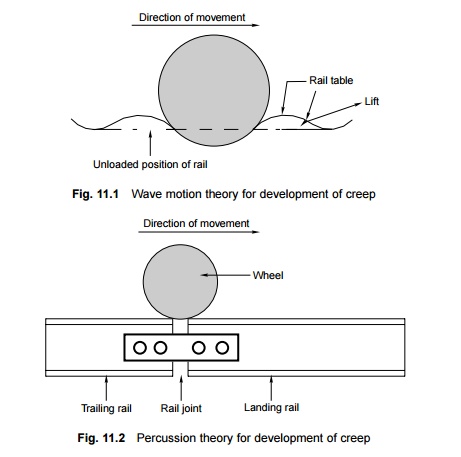Chapter: Civil : Railway Airport Harbour Engineering : Railway Engineering : Creep of Rails
Theories for the Development of Creep

Creep is defined as the longitudinal movement of the rail with
respect to the sleepers. Rails have a tendency to gradually move in the
direction of dominant traffic. Creep is common to all railway tracks, but its
magnitude varies considerably from place to place; the rail may move by several
centimetres in a month at few places, while at other locations the movement may
be almost negligible.
Theories
for the Development of Creep
Various theories have been put forward to explain the
phenomenon of creep and its causes, but none of them have proved to be
satisfactory. The important theories are briefly discussed in the following
subsections.
1
Wave Motion Theory
According to wave motion theory, wave motion is set up in the
resilient track because of moving loads, causing a deflection in the rail under
the load. The portion of the rail immediately under the wheel gets slightly
depressed due to the wheel load. Therefore, the rails generally have a wavy
formation. As the wheels of the train move forward, the depressions also move
with them and the previously depressed portion springs back to the original
level. This wave motion tends to move the rail forward with the train. The
ironing effect of the moving wheels on the wave formed in the rail causes a
longitudinal movement of the rail in the direction of traffic resulting in the
creep of the rail (Fig. 11.1).
2.Percussion Theory
According
to percussion theory, creep is developed due to the impact of wheels at the
rail end ahead of a joint. As the wheels of the moving train leave the trailing
rail at the joint, the rail gets pushed, forward causing it to move
longitudinally in the direction of traffic, and that is how creep develops.
Though the impact of a single wheel may be nominal, the continuous movement of
several of wheels passing over thc joint pushes the facing or landing rail
forward, thereby causing creep (Fig. 11.2).
3.Drag Theory
According to drag theory, the
backward thrust of the driving wheels of a locomotive has the tendency to push
the rail backwards, while the thrust of the other wheels of the locomotive
pushes the rail in the direction in which the locomotive is moving. This results
in the longitudinal movement of the rail in the direction of traffic, thereby
causing creep.
Related Topics